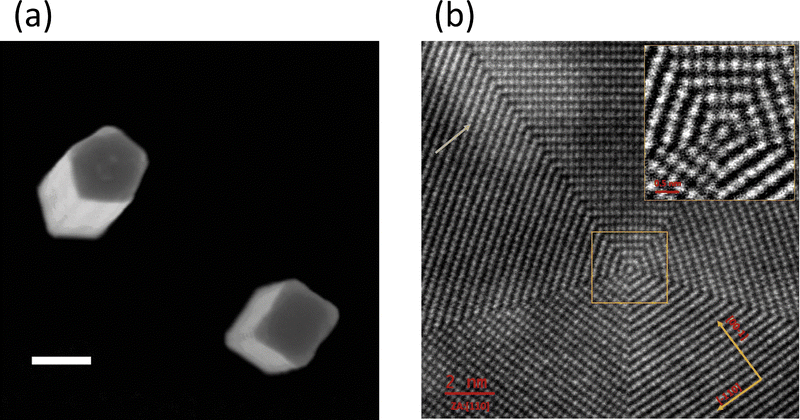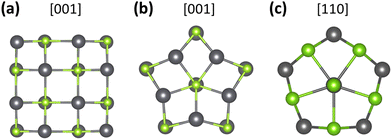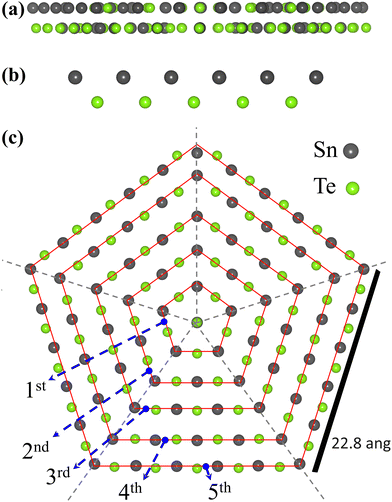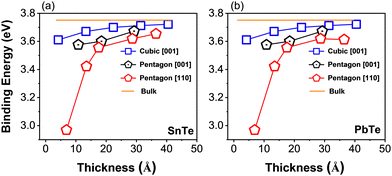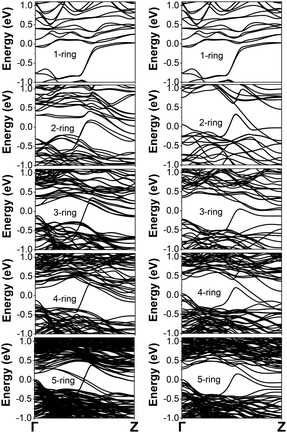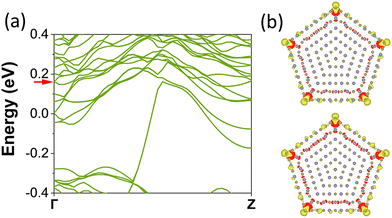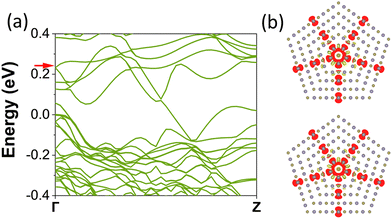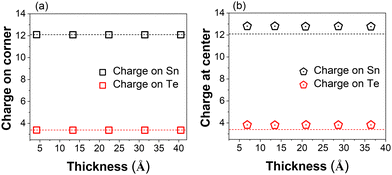Pentagonal nanowires from topological crystalline insulators: a platform for intrinsic core–shell nanowires and higher-order topology†
Ghulam
Hussain
ab,
Giuseppe
Cuono
bc,
Piotr
Dziawa
d,
Dorota
Janaszko
d,
Janusz
Sadowski
 d,
Slawomir
Kret
d,
Slawomir
Kret
 d,
Bogusława
Kurowska
d,
Jakub
Polaczyński
b,
Kinga
Warda
be,
Shahid
Sattar
f,
Carlo M.
Canali
f,
Alexander
Lau
b,
Wojciech
Brzezicki
gb,
Tomasz
Story
db and
Carmine
Autieri
d,
Bogusława
Kurowska
d,
Jakub
Polaczyński
b,
Kinga
Warda
be,
Shahid
Sattar
f,
Carlo M.
Canali
f,
Alexander
Lau
b,
Wojciech
Brzezicki
gb,
Tomasz
Story
db and
Carmine
Autieri
 *h
*h
aInstitute for Advanced Study, Shenzhen University, Shenzhen 518060, China
bInternational Research Centre MagTop, Institute of Physics, Polish Academy of Sciences, Aleja Lotników 32/46, PL-02668 Warsaw, Poland
cConsiglio Nazionale delle Ricerche (CNR-SPIN), Unitá di Ricerca presso Terzi c/o Universitá “G. DAnnunzio”, 66100 Chieti, Italy
dInstitute of Physics, Polish Academy of Sciences, Aleja Lotników 32/46, PL-02668 Warsaw, Poland
eFaculty of Applied Physics and Mathematics, Gdansk University of Technology, Gdańsk 80-233, Poland
fDepartment of Physics and Electrical Engineering, Linnaeus University, 392 31 Kalmar, Sweden
gInstitute of Theoretical Physics, Jagiellonian University, ulica S. ojasiewicza 11, PL-30348 Kraków, Poland
hInternational Research Centre MagTop, Institute of Physics, Polish Academy of Sciences, Aleja Lotników 32/46, PL-02668 Warsaw, Poland. E-mail: autieri@magtop.ifpan.edu.pl
First published on 17th May 2024
Abstract
We report on the experimental realization of Pb1−xSnx Te pentagonal nanowires (NWs) with [110] orientation using molecular beam epitaxy techniques. Using first-principles calculations, we investigate the structural stability of NWs of SnTe and PbTe in three different structural phases: cubic, pentagonal with [001] orientation and pentagonal with [110] orientation. Within a semiclassical approach, we show that the interplay between ionic and covalent bonds favors the formation of pentagonal NWs. Additionally, we find that this pentagonal structure is more likely to occur in tellurides than in selenides. The disclination and twin boundary cause the electronic states originating from the NW core region to generate a conducting band connecting the valence and conduction bands, creating a symmetry-enforced metallic phase. The metallic core band has opposite slopes in the cases of Sn and Te twin boundaries, while the bands from the shell are insulating. We finally study the electronic and topological properties of pentagonal NWs unveiling their potential as a new platform for higher-order topology and fractional charge. These pentagonal NWs represent a unique case of intrinsic core–shell one-dimensional nanostructures with distinct structural, electronic and topological properties between the core and the shell region.
New conceptsThe authors deliver an extremely original paper on the experimental realization and the theoretical study of Pb1−xSnxTe pentagonal nanowires (NWs). Indeed, to the best of authors' knowledge, this is the first experimental realization of pentagonal nanowires based on an ionic compound, since it is not straightforward to accommodate positive and negative charges on a polygonal shape with an odd number of sides. There are different structural properties between the core and the shell of the nanowires even if the chemical elements and composition are the same; therefore, we have synthesized unique intrinsic core–shell one-dimensional nanowires with distinct properties between the core and the shell region of the nanowires. At the center of the nanowires, we have a line defect named disclination. The disclination and twin boundary cause the electronic states originating from the NW core region to generate a conducting band connecting the valence and conduction bands, creating a symmetry-enforced metallic phase. We study the topological properties related to the central chain of pentagonal NWs using a tight-binding model connecting our model to the deeply studied SSG model with the addition of defects. Finally, we unveil these pentagonal NWs as potential candidates for higher-order topology. |
1 Introduction
Three-dimensional topological insulators have gapped bulk states but feature gapless conducting edge states dictated by a bulk topological invariant and protected by relevant symmetries. Higher-order band topological insulators (HOTIs) provide lower-dimensional boundary states as gapless hinge or corner states.1–3 Within the magnetic topological insulators, the axion insulating phase is an example of higher-order topology proposed in compounds and superlattices.4–6 Very few real materials have been proposed for the experimental realization of HOTIs, and two of the most popular are bismuth7 and cubic SnTe nanowires (NWs).8 Indeed, it was proposed that the cubic SnTe NWs under rhombohedral strain can host a helical higher-order topological insulator phase.8 This is protected by both mirror and time-reversal symmetry, but no inversion symmetry is needed for helical HOTIs in SnTe. The rhombohedral strain plays the role of suppressing the first-order topology to make the second-order topology visible.8 Recently, a new route was proposed to obtain higher-order topological insulators9–12 or fractional charges through defects or dislocations.13,14 In the case of disclinations, the system can host strong second-order topological phases provided that local C2, C4, or C6 symmetries protecting the topological phase are present;9 the same happens for one-dimensional disclinations.15Group IV–VI semiconductors are known to display interesting characteristics, including thermoelectric effects,16,17 ferroelectric behavior,18,19 and superconducting properties.20,21 Notably, the identification of a topological crystalline insulating (TCI) phase in materials such as SnTe,22–26 along with certain related substitutional compounds such as Pb1−xSnx Te27 and Pb1−xSnx Se,28,29 has sparked significant interest in the realm of research. This category of materials has garnered substantial attention for further investigation. The TCI phase stands apart from the conventional topological insulating phase, as the linearly dispersing Dirac states on the high-symmetry surfaces of TCIs are protected by crystal symmetries30 rather than time-reversal symmetry. Consequently, the topological invariant is also different. For example, in the case of SnTe and its alloys, the invariant is named the mirror Chern number23,31–34 because the symmetry which protects the surface states is a reflection of the crystal with respect to the (110) mirror plane. Changing the dimensions or the size (whether in a 2D or 3D configuration) of materials results in the modification of their distinctive properties. Notably, a transition from bulk35–37 to thin films38–40 induces property variations. A case in point is SnTe: while it behaves as a trivial insulator at reduced thicknesses, it assumes a topological nature beyond a critical thickness,32,41–44 displaying strong robustness against impurity doping.45 Employing scanning tunneling microscopy and spectroscopy on Pb1−xSnx Se, it was demonstrated that the (001) surface hosts large terraces interspersed with step edges of varying heights. The features of low-energy states occurring at surface atomic steps have been investigated, along with an exploration of the response of these edge channels to the stoichiometry of the alloy.21,46–49
The impacts resulting from the existence of defects in the TCIs were also investigated in the literature. Possible defects are disclinations or dislocations, which naturally occur in the material during its growth. These are defects that interrupt the rotational or translational symmetry in a region of the material. Fractional electric charges were observed in disclinations,13,14,50 and it was shown that these defects can probe higher-order topology,7,8,51 and the criteria for a zero-energy Majorana bound state to be present at defects were given.52,53 Partial-dislocation-induced topological modes in 2D and 3D higher-order topological insulators were experimentally observed.54 In the recent past, an investigation was undertaken to explore the connection between twinning in thin films and variations in the mirror Chern number.55
Exploring the one-dimensional (1D) case, the topological crystalline insulator SnTe NWs emerge as even more captivating than their bulk counterparts. This enhanced intrigue arises from the amplified contribution originating from topological surface states and the effects of confinement in 1D systems.56–59 Diverse approaches were uncovered to produce SnTe NWs. These methods encompass the utilization of high-yield alloy nanoparticles as growth catalysts,19 graphene60 and employing single-walled carbon nanotubes to produce the smallest possible SnTe NWs.61 SnTe NWs have also been thoroughly investigated theoretically. It was shown that it is possible to obtain distinct topological states through the application of varied fields.62 Notably, bulk Majorana modes appear in the presence of inversion symmetry, while the imposition of symmetry-breaking fields at the NW ends leads to the emergence of Majorana zero modes, alongside the gapping of the Majorana bulk modes.62 Cubic Pb1−xSnx Te NWs have also been synthesized.63–66 TCI NWs can serve as a platform to confine and control Dirac fermions,67 while PbTe NWs have drawn attention due to their potential to host Majorana zero modes.68,69 However, the realization of Majoranas fermions is challenging as it requires the growth of NWs to be integrated with a circuit that exhibits the necessary sensitivity to monitor individual electrons as they traverse through it. All of this intricate work must be conducted at extremely low temperatures and within a magnetic field that is 10,000 times stronger than Earth's field.70
Ab initio calculations were applied to investigate ultrathin cubic NWs71,72 and to find the critical thicknesses at which SnTe NWs go from a trivial insulating regime to a spin–orbit insulating phase and then to the TCI phase.72 Great attention was recently dedicated to 2D pentagonal materials in different types of the Cairo pentagonal tessellation73–75 and their topological properties.76 Studies are also present for 1D pentagonal materials referred to as penta-twinned nanowires; however, only elemental and non-ionic pentagonal NWs have been experimentally realized77–79 or theoretically proposed.80–83
In this article, we study the structural, electronic and topological properties of the SnTe pentagonal NWs with [110] orientation. Compared to the literature,13 our system differs in its [110] orientation, periodicity along the z-direction and in hosting a core chain (CC) that produces peculiar properties. First, we report the experimental realization of Pb1−xSnx Te ionic pentagonal NWs using the molecular beam epitaxy technique. Then we investigate, by means of ab initio and model Hamiltonian calculations, the structural, electronic and topological properties of pentagonal PbTe and SnTe NWs with anionic and cationic twin boundaries. We find that the cubic [001] NWs show a robust insulating behavior,72 while the pentagonal NWs are metastable with a more covalent bond. This more covalent bond brings smaller band gaps and therefore favors the topological phases. We investigate the evolution of the band gap as a function of the thickness and we study the topology of the pentagonal NWs.
The article is organized as follows: in the next section, the experimental realization of the ionic pentagonal NWs is described, and the third section is instead devoted to the theoretical investigation of the structural, electronic and topological properties of the pentagonal NWs. In the fourth and last section, we draw our conclusions.
2 Experimental realization of ionic pentagonal nanowires
Pb1−xSnx Te NWs were grown using the molecular beam epitaxy (MBE) approach within a home-built apparatus furnished with solid sources of SnTe, Pb, and Te (refer to Appendix A in the ESI† for more comprehensive information). The NWs obtained using this method have typical lengths exceeding 1 μm, with a NW growth rate surpassing 0.5 μm h−1. The NW diameters display a relatively broad range, spanning from a minimum of approximately 15 nm to as much as 200 nm. The peak distribution rests at around 40–80 nm. Under these specific conditions, both varieties of NWs are observed: those manifesting a four-fold and those with a five-fold symmetry in their cross-sectional profiles (see Fig. 1a). Utilizing a scanning electron microscope, we conducted observations at 5 kV, with magnifications ranging from 10k to 300k x. The SEM imagery reveals a diverse NW length, spanning from 0.7 μm to 3 μm, while the width of the structures spans between 40 nm and 150 nm. On the substrate, a prevalent occurrence of five-fold NWs was noted, with less frequent instances of four-fold NWs. These structures exhibit remarkable symmetry and well-defined shapes, displaying evident blocks. The NW surfaces exhibit a flawlessly smooth texture devoid of imperfections.To explore the structural attributes of the Pb1−xSnx Te NWs, we employed a transmission electron microscope. This analysis involved cross-sectioned NWs inspected along the [110] zone axis, which aligns with the NW growth axis. Both scanning transmission electron microscopy (STEM) and high-resolution transmission electron microscopy modes were employed. The presence of five-fold symmetry was conclusively established. Furthermore, distinct features such as the (111) plane twin boundaries were discernible, along with brighter areas indicative of twinning. These areas are related to strain fields. In Fig. 1b we show the STEM top view image of the five-fold Pb1−xSnx Te NW. At the core of the pentagonal structure, we have a one-dimensional disclination that follows the length of the pentagonal NW. The disclination is described by the Frank angle,13 which in this case is +90°. Despite having cubic domains between the twin boundaries, the pentagonal NWs present a 1D disclination and five twin-boundary planes; even if these planes are extended defects, their effect on the structure is local so that most of the whole volume of the NW is in cubic arrangement making this phase equivalent to the cubic structure from the thermodynamic point of view.84 From the experimental data, the twin boundaries of the experimentally obtained pentagonal nanowires seem to be composed of anion atoms.
3 Structural and electronic properties
We divide this section into three subsections devoting the first to the study of the structural properties, the second to the electronic band structure results and the third to the topological properties. We will work on SnTe and PbTe in the first two subsections, showing that they have the same properties at least in the thin limit. In the third and fourth sections, we will then investigate the topological properties focusing only on the SnTe NWs.3.1 Structural stability of the nanowires
Using density functional theory (DFT) calculations, we compare the energetic stability of the three NW crystal structures. The computational details of the calculations are reported in Appendix B in the ESI.† We study the cubic NWs with [001] growth orientation and the two growth orientations [001] and [110] for the pentagonal NWs. The pentagonal structures have 5 mirror planes that coincide with the plane of the twin boundaries. The pentagonal structure with [110] orientation is the phase observed in experiments. The three optimized structures of thin SnTe NWs are illustrated in Fig. 2. In Fig. 3, we report the side and top view of the [110] pentagonal NWs. The [110] pentagonal NW is composed of a core region and a shell region. The core region is composed of a core chain (CC) along the z-axis where the atoms experience an environment with C5 rotational symmetry. Additionally, there is a mirror plane at z = 0 or z = 0.5, but there is no inversion point. The forces acting on the atoms of the core chain (one Sn and one Te atom per unit cell) are zero by symmetry. Indeed, the forces along the z-axis are compensated by the mirror symmetry, while for the in-plane components, the sum of the forces of equivalent atoms located at the vertex of a regular pentagon on the center is zero. The shell region is composed of the 5 twin boundaries that separate regions where the system is locally cubic and where the atoms locally experience the C4 symmetry present in the bulk system. As we can see, the thickness of these NWs can be increased by adding more rings of the corresponding atoms to the edges (sides) of each NW. In this way, the pentagonal NWs are named as 1-ring, 2-ring, 3-ring, 4-ring and 5-ring, respectively.To examine the stability of such NW systems, the ground state binding energies per atom are calculated from the ground state total energies obtained via DFT:80,85
DFT calculations of the pentagonal nanowires with Pb0.50Sn0.50 Te composition do not change the scenario from the point of view of the total energy, indicating that the formation of pentagonal NWs comes from a less likelihood to obtain Pb0.50Sn0.50 Te cubic NWs. In order to further understand the stability of the pentagonal nanowires, we discuss the unique characteristics of Pb0.50Sn0.50 Te. Well, close to this composition, we have the closure of the band gap with the topological transition in the bulk samples or thick cubic NWs at room temperature.87 The cubic structures of Pb1−xSnx Te are stabilized by the ionic insulator character described by the Madelung constant, while metallic systems tend to have a more hexagonal structure to produce a large atomic packing factor and covalent bonds. We propose that the thick cubic Pb0.50Sn0.50 Te NWs with a zero gap are structurally less stable than SnTe and PbTe NWs, such that the pentagonal Pb0.50Sn0.50 Te NWs are more likely to grow. To test this claim at the quantum mechanical level, we would need to reproduce the energetic stability of the alloyed cubic and pentagonal NWs using DFT, however, we are not able to simulate cubic NWs with spin–orbit coupling above a thickness of 15 nm.72 Therefore, we move to a semiclassical approach to provide insight on the formation of the disclination in the initial stages of the growth.
A semiclassical approach to describing the stability of ionic pentagonal NWs has been reported in Appendix C in the ESI.† Within the semiclassical approach, for the cube, the Madelung constant is highest and particle density is lowest, indicating that the contribution of the ionic bond is larger than the covalent one. In the case of the hexagon, particle density is the highest and the Madelung constant is the lowest, indicating that the covalent bond is the dominant character of binding. However, the pentagonal structure bears intermediate values, which implies that if the bond is partially ionic and partially covalent, the pentagonal system is expected to be the most stable one. Basically, the pentagonal structure arises from the interplay between the ionic bond and the covalent bond. The pentagonal NW tends to be stabilized in a more covalent environment which is favored by small gaps and metallicity as observed near the topological transition in Pb0.50Sn0.50 Te. In the ESI,† we conclude that NWs based on Pb and Te would be more likely to form this unusual pentagonal structure because they will have weaker ionic bonds.
Further research is necessary to advance towards the alloyed phase Pb1−xSnx Te. Our preliminary results indicate that the difference between the binding energy of the cubic and pentagonal NWs decreases to smaller values in the alloy. Exploring the possibility that the CC consists solely of either Sn or Pb atoms could be a direction worth investigating. In this regard, employing genetic algorithms might predict the crystal structure and the cationic composition of the CC.86
3.2 Electronic properties of the pentagonal nanowires
In general, as we decrease the thickness, we can observe a bandwidth reduction. The bandwidth reduction brings metals and topological systems into the trivial insulating phase.72,88,89 For the cubic PbTe NWs, the band gap decreases as the thickness increases. For the ultrathin cubic SnTe NWs, we have a trivial insulating behavior with the band gap decreasing as we increase the thickness up to the appearance of a trivial spin–orbit insulating phase, and by further increasing the thickness, the topological phase emerges.72To see the effect of thickness dependence on the electronic properties of pentagonal NWs, we considered the [110] oriented pentagonal SnTe NWs for different thicknesses. We report the electronic band structures including the SOC effects for two cases of the [110] oriented SnTe pentagonal NWs with Sn on the twin boundaries and Te on the twin boundaries. The band structures of the SnTe and PbTe pentagonal NWs without SOC included are instead shown in Appendix D in the ESI,† and no major differences are observed between SnTe and PbTe. However, the two pentagonal NWs with different twin boundaries show different properties as also observed in [111] thin films.55 In Fig. 5, we show the two cases with different twin boundaries, where all the band structures reveal metallic behavior with bands connecting the valence and conduction electrons. While the behavior as a function of the thickness does not change for the Te twin-boundary NWs, for the 5-ring NW with Sn twin-boundary, we observe an additional band connecting the valence and conduction band that seems to close and invert the band gap at the Γ point. We observe a reduction of the band gap at Γ but not at the Z point, strongly indicating that the two high-symmetry k-points are different from the topological point of view. In Appendix E in the ESI,† we show that the core chain (CC) of atoms is responsible for the metallicity in these systems. Indeed, the band connecting the valence and conduction electrons disappears when the core chain of atoms is removed within DFT calculations.
In addition to the C5 symmetry of the global system, it was also shown that the local C4 symmetry is relevant. Since the preservation of local C4 symmetry in the region among the twinning is crucial for the observation of the higher-order topology,9 we study the band structure of the pentagonal NWs with [110] orientation and perfect local C4 symmetry (without structural relaxation). We define this crystal structure without structural relaxations as a high-symmetric pentagonal NW. We show the electronic band structures and charge densities for the most symmetric 5-ring SnTe pentagonal NW with Sn and Te on the twin boundaries as shown in Fig. 6 and 7. In the band structure of Fig. 6(a) and 7(a), we observe a two-times degenerate band connecting the valence and conduction bands with a positive slope for the Sn-twin boundary and a negative slope for the Te-twin boundary. In the case of the Te-twin boundary, we calculate the charge density at the Γ point associated with the band connecting valence and conduction bands as shown in Fig. 7(b). Its charge is shared between the CC and the Sn atoms on the 5 mirror planes. Supported by the results presented in the model Hamiltonian, we assume that a similar state is also present in the Sn twin boundary NWs but in the conduction band and more hybridized with other bands.
To gain further insight, we perform tight-binding calculations using the model Hamiltonian for a section of the SnTe pentagonal NWs. The tight binding model was reported in previous literature47,62 and it was derived from the Shiozaki–Sato–Gomi (SSG) model90 (for more details, see Appendix H in the ESI†). We use as a section the mirror plane shown in Fig. 8(a) for a minimal model of the experimental system where the CC acts as a termination defect of the SSG model. In Fig. 8(b), the results for the Sn twin boundary describe a metallic band connecting the valence and conduction band associated with the CC. Even if this band is quite localized in the CC, the hybridization with the shell of the NWs described by the hopping t3 is extremely relevant. Indeed, without the coupling between the core and shell, the metallic band disappears as shown in Fig. 8(c). Exchanging anions and cations to change the twin boundary, we obtain a band structure for the Te twin-boundary shown in Fig. 8(d). With the Te twin boundary, we obtain the CC state to have a negative slope. Fig. 8(e) describes a simpler model with periodicity along the z-direction that further confirms the relevance of the CC as a termination defect of the SSG model for the formation of the metallic bands in pentagonal NWs. Basically, in both twin boundary cases, the CC band connects the valence and conduction bands enforcing metallicity even in the ultrathin limit. Therefore, the pentagonal NWs are intrinsic core–shell NWs composed of a single material with a metallic chain in the core and an insulating cubic SnTe shell. The core and shell are electronically and structurally different but consist of the same constituent elements and stoichiometry.
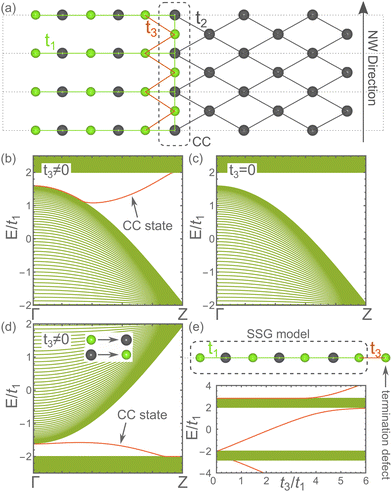 | ||
| Fig. 8 Effective SSG-like ribbon model, the gray/green dots represent Sn and Te atoms with opposite on-site potentials ±m defined in the model.47 (a) The transverse cross-section of the NW with the CC. Its length is equal to twice the number of rings. (b) and (c) The spectra of the ribbon system are periodic in the NW direction. In case (b), there is a non-vanishing hopping amplitude t3 and we find a state strongly localized at the CC shown as a red line. In the case of lack of this t3 hopping (c), we do not find the band connecting the valence and conduction bands. (d) Same as (b) reversing anions and cations, in both (b) and (d), the Fermi level crosses the red line coming from the CC. (e) The minimal SSG model with termination defect and its spectrum showing end-states. The parameters are: m = 2t1, t2 = t3 = 0.9t1. | ||
3.3 Tunability of pentagonal nanowire growth
Starting from the general aspects, we need to weaken the ionic bonds, favoring the formation of pentagonal nanowires as discussed in the previous subsections. Once the ionic part of the bond is weakened and the system is more covalent, the formation of pentagonal structures depends on the ratio of growth rates in the (100) and (111) directions, which is responsible for the twinning.91,92 Many works on fivefold symmetry focus on nanoparticles. In addition to elemental materials, various covalent alloys, compounds, and composite nanoparticles grow with fivefold twinned structures.93Regarding the specific (Pb,Sn)Te system, we report the growth conditions that favor the formation of the pentagonal nanowires. We have hints of nucleation but no conclusive evidence of nucleation of the central chain from several experiments (TEM of the NW//Si interface; STM at the center of the cross-section; detailed analysis of growth as a function of conditions). In the case of ternary (Pb,Sn)Te, the deviation of the chemical composition from x = 0.5 (estimated for the layers based on the base of beam equivalent pressure) dramatically reduces the occurrence of 5-fold NWs. A change in the Te/Pb flux ratio of about 20% from the optimal for 5-fold NW growth results in growth NWs with 4-fold symmetry. Therefore, in order to observe the pentagonal nanowires, the doping concentration should be around x = 0.50 i.e. close to the critical concentration where there is topological transition at room temperature.87 Based on the experimental data, the slight excess of Pb in the total flux of (Pb,Sn)Te supports the nucleation of islands with structures other than 4-fold symmetry. This agrees with our theoretical results supporting the presence of heavy atoms as necessary for the pentagonal NWs. Regarding the temperature, for similar values of SnTe, Pb, and Te molecular fluxes, 5-fold NWs are observed at higher growth temperatures in the range where cubic NW growth is not observed at all. Therefore, high temperature is required because our theoretical results suggest that the pentagonal structure is metastable at low temperatures.
Additionally, the crystal structure can be switched from cubic to pentagonal forms during the growth process to create heterostructure nanowires as shown in Fig. 9. In particular, this is the result of the PbTe/(Pb,Sn)Te//Si(100) growth process. In the first part of the growth, the growth of (Pb,Sn)Te was performed, while in the second part, we grew PbTe. The growth of PbTe was carried out by turning off the SnTe flux for initial (Pb,Sn)Te and the PbTe flux remained unchanged. Hence, it suggests that both parts consist of (Pb,Sn)Te rather than PbTe/(Pb,Sn)Te. Further studies would be needed to establish the chemical composition of both parts of these NW heterostructures. More technical details are reported in Appendix A in the ESI.†
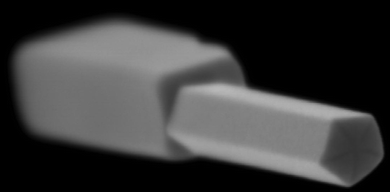 | ||
| Fig. 9 Heterostructure nanowire obtained by tuning the flux during the growth process to switch from the cubic to the pentagonal structure. | ||
3.4 Topological electronic states in the core chain of the pentagonal nanowires
Regarding the topological properties, we analyze two aspects of the pentagonal nanowires. In this subsection, we analyze the topological properties related to the core chain, while in the next subsection, we report the signature of the topological properties related to the fractional charge and hinge states.The electronic properties of the core chain were understood using a simplified SSG model Hamiltonian derived from a ribbon of a topologically non-trivial model with a nonsymmorphic chiral Z2 invariant.94 This model (known also as the Rice-Mele model) was also used to study the presence of topological midgap corner modes in n-fold rotational symmetric chiral insulators to investigate the existence of a HOTI protected by rotational symmetry.95 The cross-section of the NW that was used for the model Hamiltonian is shown in Fig. 8(a), with the three hopping parameters of the model named as t1, t2 and t3. When the hopping t3 is zero, there are no bands connecting the valence and conduction band and the system is an insulator as shown in Fig. 8(c). When t3 is different from zero, this model provides electronic states inside the gap connecting the valence and conduction bands resulting in a symmetry-enforced metallic phase. In the case of Sn on the twin boundary shown in Fig. 8(b), the connecting band has a positive slope, while it has a negative slope in the case of Te on the twin boundary plotted in Fig. 8(d). The robustness of this symmetry-enforced metallic phase was also confirmed through linear scaling DFT calculations (Appendix F in the ESI†) and through DFT calculations of the NWs under isotropic pressure (Appendix G in the ESI†). These results demonstrate that the electronic properties critically depend on the composition of the CC. The minimal model that reproduces this metallic phase is a SSG model with a termination defect as shown in Fig. 8(e). Note that a pure SSG model without termination defects exhibits no end-states.94 This is because the termination of the system breaks the nonsymmorphic chiral symmetry that protects the Z2 topological invariant. However, in the presence of the topological invariant, there is charge accumulation at the edges, in strict analogy to the 1D systems with inversion symmetry.96 We find that with termination defect such accumulation can again lead to the appearance of the end-states.
3.5 Signature of fractional charge and higher-order topology in pentagonal nanowires
Now, we move to describe the signatures of higher-order topology as the hinge states. The hinge states for SnTe cubic nanowires (grown along the [001] orientation presenting a square section) were observed at a given k-point that was close to the edge of the Brillouin zone.62,67 In the case of the Sn twin boundary, we analyzed the charge density at the Γ point as shown in Fig. 6(b). Localized charge densities are visible at the corners of the 5-ring pentagonal NW. We surmise that this state will evolve in the localized higher-order topological state once the thickness of the shell is large enough to generate the TCI state of SnTe. While there exist recent studies focused on higher-order topology in finite systems in the xy plane, additional studies are necessary for the higher-order topology in NWs that are periodic along the z-direction and finite in the xy plane.In addition to hinge states, another feature of the higher-order topology is the presence of a fractional charge at the center. Fig. 10(a) and (b) show the charge for the SnTe cubic and pentagonal NWs, respectively. We also report for comparison the charge in the bulk SnTe. The charges on both Sn and Te of the CC substantially increase with respect to the charge in the bulk and are constant as a function of the thickness. This excess of charge could be associated with the fractional charge appearing in the presence of disclinations. The fractional charge can be observed with and without topology. Fractional charge and higher-order topology are strongly developed in 2D materials but these are less evident in NWs. We leave it to future studies to provide for a deeper explanation of the fractional charge. The interplay between the topological properties from the core and from the shell will be described elsewhere.97
4 Conclusions
We have synthesized ionic pentagonal NWs of Pb1−xSnx Te with smooth texture devoid of imperfections. Within a semiclassical approach, the pentagonal crystal structure is stabilized by an interplay between the ionic bond and the covalent bond. Within a full quantum approach, we have demonstrated that the pentagonal structure of the SnTe NWs represents a metastable phase at T = 0 but it is close in energy to the ground state, which is the cubic structure. Therefore, we need to weaken the ionic bond by incorporating heavy atoms such as Pb and Te and approach the topological transition. Finally, the growth of the pentagonal NWs should take place at high temperatures because they are not stable at low temperatures. The pentagonal NWs are an intrinsic core–shell system where the core and shell have different structural, electronic and topological properties. The pentagonal NWs with [110] orientations are metallic due to the presence of a single band connecting the conduction and valence bands coming from the one-dimensional disclination in the core of the NW. This connecting band clearly comes from the one-dimensional disclination and it is related to the properties of the topological SSG model. We have found an excess charge in the center that could be associated with a fractional charge. We have calculated the charge in the real space related to the degenerate electronic states at the Γ point and we find that these states are associated with higher-order topological states at the hinges of the NWs. The pentagonal NWs are a platform for higher-order topology and fractional charge. These pentagonal NWs represent a unique case of intrinsic core–shell NWs with distinct structural, electronic and topological properties between the core and the shell.Author contributions
G. Hussain: investigation, methodology, validation, data curation, and writing – original draft. G. Cuono: investigation, methodology, validation, data curation, and writing – original draft. P. Dziawa: investigation, validation, data curation, and writing – original draft. D. Janaszko: investigation, validation, data curation, and writing – original draft. J. Sadowski: funding acquisition. S. Kret: funding acquisition. B. Kurowska: investigation, methodology, and validation, J. Polaczyński: conceptualization, investigation, methodology, and validation, K. Warda: investigation, methodology, validation, data curation, and writing – original draft. S. Sattar: writing – review & editing. C. M. Canali: funding acquisition, resources, and writing – review & editing. A. Lau: validation W. Brzezicki: methodology, investigation, validation, data curation, and funding acquisition. T. Story: supervision, resources. Carmine Autieri: supervision, conceptualization, project administration, resources, and writing – review & editing.Conflicts of interest
The authors declare that they have no known competing financial interests or personal relationships that could have appeared to influence the work reported in this article.Acknowledgements
We thank T. Dietl, C. Ortix, R. Buczko and S. Samadi for useful discussions. This work is supported by the Foundation for Polish Science through the International Research Agendas program co-financed by the European Union within the Smart Growth Operational Programme (Grant No. MAB/2017/1). W. B. acknowledges support from Narodowe Centrum Nauki (NCN, National Science Centre, Poland) Project No. 2019/34/E/ST3/00404. J. S. and S. K. acknowledge support from the National Science Centre Poland through the projects 2019/35/B/ST3/03381 and 2019/35/B/ST5/03434. C. M. C. and S. S. thank Carl Tryggers Stiftelsen (CTS 20:71) and the Swedish Research Council (VR 2021-04622) for the financial support. We acknowledge the access to the computing facilities of the Interdisciplinary Center of Modeling at the University of Warsaw, Grant g91-1418, g91-1419 and g91-1426 for the availability of high-performance computing resources and support. We acknowledge the CINECA award under the ISCRA initiative IsC99 “SILENTS”, IsC105 “SILENTSG”, IsB26 “SHINY” and IsB27 “SLAM” grants for the availability of high-performance computing resources and support. We acknowledge the access to the computing facilities of the Poznan Supercomputing and Networking Center Grant No. 609 (pl0223-01) and pl0267-01. The computations at Linnaeus University were enabled by resources provided by the National Academic Infrastructure for Supercomputing in Sweden (NAISS) at Dardel partially funded by the Swedish Research Council through grant agreement no. 2022-06725.Notes and references
- B. Xie, H.-X. Wang, X. Zhang, P. Zhan, J.-H. Jiang, M. Lu and Y. Chen, Nat. Rev. Phys., 2021, 3, 520–532 CrossRef.
- G. van Miert and C. Ortix, Phys. Rev. B, 2018, 98, 081110 CrossRef.
- S. H. Kooi, G. van Miert and C. Ortix, Phys. Rev. B, 2020, 102, 041122 CrossRef CAS.
- Y. Xu, Z. Song, Z. Wang, H. Weng and X. Dai, Phys. Rev. Lett., 2019, 122, 256402 CrossRef CAS PubMed.
- R. Islam, S. Mardanya, A. Lau, G. Cuono, T.-R. Chang, B. Singh, C. M. Canali, T. Dietl and C. Autieri, Phys. Rev. B, 2023, 107, 125102 CrossRef CAS.
- N. Pournaghavi, M. F. Islam, R. Islam, C. Autieri, T. Dietl and C. M. Canali, Phys. Rev. B, 2021, 103, 195308 CrossRef CAS.
- F. Schindler, Z. Wang, M. G. Vergniory, A. M. Cook, A. Murani, S. Sengupta, A. Y. Kasumov, R. Deblock, S. Jeon, I. Drozdov, H. Bouchiat, S. Guéron, A. Yazdani, B. A. Bernevig and T. Neupert, Nat. Phys., 2018, 14, 918–924 Search PubMed.
- F. Schindler, A. M. Cook, M. G. Vergniory, Z. Wang, S. S. P. Parkin, B. A. Bernevig and T. Neupert, Sci. Adv., 2018, 4, 1–7 Search PubMed.
- M. Geier, I. C. Fulga and A. Lau, SciPost Phys., 2021, 10, 092 Search PubMed.
- F. Schindler, S. S. Tsirkin, T. Neupert, B. Andrei Bernevig and B. J. Wieder, Nat. Commun., 2022, 13, 5791 Search PubMed.
- W. A. Benalcazar, J. C. Y. Teo and T. L. Hughes, Phys. Rev. B: Condens. Matter Mater. Phys., 2014, 89, 224503 CrossRef.
- B. Roy and V. Juriĉiĉ, Phys. Rev. Res., 2021, 3, 033107 CrossRef CAS.
- C. W. Peterson, T. Li, W. Jiang, T. L. Hughes and G. Bahl, Nature, 2021, 589, 376–380 CrossRef CAS PubMed.
- Y. Liu, S. Leung, F.-F. Li, Z.-K. Lin, X. Tao, Y. Poo and J.-H. Jiang, Nature, 2021, 589, 381–385 CrossRef CAS PubMed.
- Y. Zhang, C. Liu, X. Dai and Y. Xiang, Phys. Rev. B, 2023, 107, 214108 CrossRef CAS.
- H. Wang, Y. Pei, A. D. LaLonde and G. J. Snyder, Adv. Mater., 2011, 23, 1366–1370 CrossRef CAS PubMed.
- C. Wood, Rep. Prog. Phys., 1988, 51, 459 CrossRef CAS.
- A. I. Lebedev and I. A. Sluchinskaya, Ferroelectrics, 1994, 157, 275–280 CrossRef CAS.
- P. Liu, H. J. Han, J. Wei, D. J. Hynek, J. L. Hart, M. G. Han, C. J. Trimble, J. R. Williams, Y. Zhu and J. J. Cha, ACS Appl. Electron. Mater., 2021, 3, 184–191 CrossRef CAS.
- Y. Matsushita, P. Wianecki, A. T. Sommer, T. Geballe and I. Fisher, Phys. Rev. B: Condens. Matter Mater. Phys., 2006, 74, 134512 CrossRef.
- G. P. Mazur, K. Dybko, A. Szczerbakow, J. Z. Domagala, A. Kazakov, M. Zgirski, E. Lusakowska, S. Kret, J. Korczak, T. Story, M. Sawicki and T. Dietl, Phys. Rev. B, 2019, 100, 041408(R) CrossRef.
- L. Fu, Phys. Rev. Lett., 2011, 106, 106802 CrossRef PubMed.
- T. H. Hsieh, H. Lin, J. Liu, W. Duan, A. Bansil and L. Fu, Nat. Commun., 2012, 3, 1–7 Search PubMed.
- A. Lau and C. Ortix, Phys. Rev. Lett., 2019, 122, 186801 CrossRef CAS PubMed.
- Y. Tanaka, Z. Ren, T. Sato, K. Nakayama, S. Souma, T. Takahashi, T. Takahashi, K. Segawa and Y. Ando, Nat. Phys., 2012, 8, 800–803 Search PubMed.
- Y. Okada, M. Serbyn, H. Lin, D. Walkup, W. Zhou, C. Dhital, M. Neupane, S. Xu, Y. J. Wang, R. Sankar, F. Chou, A. Bansil, M. Z. Hasan, S. D. Wilson, L. Fu and V. Madhavan, Science, 2013, 341, 1496–1499 CrossRef CAS PubMed.
- S.-Y. Xu, C. Liu, N. Alidoust, M. Neupane, D. Qian, I. Belopolski, J. Denlinger, Y. Wang, H. Lin and L. A. Wray, et al. , Nat. Commun., 2012, 3, 1–11 Search PubMed.
- P. Dziawa, B. Kowalski, K. Dybko, R. Buczko, A. Szczerbakow, M. Szot, E. usakowska, T. Balasubramanian, B. M. Wojek and M. Berntsen, et al. , Nat. Mater., 2012, 11, 1023–1027 CrossRef CAS PubMed.
- A. Łusakowski, P. Bogusławski and T. Story, Phys. Rev. B, 2023, 108, 125201 CrossRef.
- L. Fu, C. L. Kane and E. J. Mele, Phys. Rev. Lett., 2007, 98, 106803 CrossRef PubMed.
- J. C. Y. Teo, L. Fu and C. L. Kane, Phys. Rev. B: Condens. Matter Mater. Phys., 2008, 78, 045426 CrossRef.
- S. Safaei, M. Galicka, P. Kacman and R. Buczko, New J. Phys., 2015, 17, 063041 CrossRef.
- G. Cuono, G. Hussain, A. Fakhredine and C. Autieri, Acta Phys. Pol., A, 2022, 142, 521 CrossRef CAS.
- R. Rechciński, M. Galicka, M. Simma, V. V. Volobuev, O. Caha, J. Sánchez-Barriga, P. S. Mandal, E. Golias, A. Varykhalov, O. Rader, G. Bauer, P. Kacman, R. Buczko and G. Springholz, Adv. Funct. Mater., 2021, 31, 2008885 CrossRef.
- E. Plekhanov, P. Barone, D. Di Sante and S. Picozzi, Phys. Rev. B: Condens. Matter Mater. Phys., 2014, 90, 161108 CrossRef.
- H. Wang, P. Gopal, S. Picozzi, S. Curtarolo, M. Buongiorno Nardelli and J. Sławińska, npj Comput. Mater., 2020, 6, 161108 Search PubMed.
- P. Barone, T. C. V. Rauch, D. Di Sante, J. Henk, I. Mertig and S. Picozzi, Phys. Rev. B: Condens. Matter Mater. Phys., 2013, 88, 045207 CrossRef.
- J. Sławińska, F. T. Cerasoli, P. Gopal, M. Costa, S. Curtarolo and M. B. Nardelli, 2D Mater., 2020, 7, 025026 CrossRef.
- V. V. Volobuev, P. S. Mandal, M. Galicka, O. Caha, J. Sánchez-Barriga, D. Di Sante, A. Varykhalov, A. Khiar, S. Picozzi, G. Bauer, P. Kacman, R. Buczko, O. Rader and G. Springholz, Adv. Mater., 2017, 29, 1604185 CrossRef PubMed.
- K. Liu, J. Lu, S. Picozzi, L. Bellaiche and H. Xiang, Phys. Rev. Lett., 2018, 121, 027601 CrossRef PubMed.
- J. Liu, T. H. Hsieh, P. Wei, W. Duan, J. Moodera and L. Fu, Nat. Mater., 2014, 13, 178–183 CrossRef CAS PubMed.
- J. Liu, X. Qian and L. Fu, Nano Lett., 2015, 15, 2657–2661 CrossRef CAS PubMed.
- H. Ozawa, A. Yamakage, M. Sato and Y. Tanaka, Phys. Rev. B: Condens. Matter Mater. Phys., 2014, 90, 045309 CrossRef CAS.
- J. Liu and L. Fu, Phys. Rev. B: Condens. Matter Mater. Phys., 2015, 91, 081407 CrossRef.
- O. Arroyo-Gascón, Y. Baba, J. I. Cerdá, O. de Abril, R. Martínez, F. Domínguez-Adame and L. Chico, Nanoscale, 2022, 14, 7151–7162 RSC.
- P. Sessi, D. Di Sante, A. Szczerbakow, F. Glott, S. Wilfert, H. Shmidt, T. Bathon, P. Dziawa, M. Greiter, M. Neupert, M. Greiter, T. Neupert, G. Sangiovanni, T. Story, R. Thomale and M. Bode, Science, 2016, 354, 1269–1273 CrossRef CAS PubMed.
- W. Brzezicki, M. M. Wysokiński and T. Hyart, Phys. Rev. B, 2019, 100, 121107(R) CrossRef.
- G. Wagner, S. Das, J. Jung, A. Odobesko, F. Küster, F. Keller, J. Korczak, A. Szczerbakow, T. Story, S. S. P. Parkin, R. Thomale, T. Neupert, M. Bode and P. Sessi, Nano Lett., 2023, 23, 2476–2482 CrossRef CAS PubMed.
- R. Rechciński and R. Buczko, Phys. Rev. B, 2018, 98, 245302 CrossRef.
- C. Ortix, Nature, 2016, 589, 356–357 CrossRef PubMed.
- B. Roy and V. Juriĉiĉ, Phys. Rev. Res., 2021, 3, 033107 CrossRef CAS.
- W. A. Benalcazar, J. C. Y. Teo and T. L. Hughes, Phys. Rev. B: Condens. Matter Mater. Phys., 2014, 89, 224503 CrossRef.
- Y. Chen, Y. Yin, Z.-K. Lin, Z.-H. Zheng, Y. Liu, J. Li, J.-H. Jiang and H. Chen, Phys. Rev. Lett., 2022, 129, 154301 CrossRef CAS PubMed.
- S. S. Yamada, T. Li, M. Lin, C. W. Peterson, T. L. Hughes and G. Bahl, Nat. Commun., 2022, 13, 2035 CrossRef CAS PubMed.
- S. Samadi, R. Rechciński and R. Buczko, Phys. Rev. B, 2023, 107, 205401 CrossRef CAS.
- J. Shen and J. J. Cha, Nanoscale, 2014, 6, 14133–14140 RSC.
- E. Z. Xu, Z. Li, J. A. Martinez, N. Sinitsyn, H. Htoon, N. Li, B. Swartzentruber, J. A. Hollingsworth, J. Wang and S. X. Zhang, Nanoscale, 2015, 7, 2869–2876 RSC.
- M. Safdar, Q. Wang, M. Mirza, Z. Wang, K. Xu and J. He, Nano Lett., 2013, 13, 5344–5349 CrossRef CAS PubMed.
- Z. Li, S. Shao, N. Li, K. McCall, J. Wang and S. X. Zhang, Nano Lett., 2013, 13, 5443–5448 CrossRef CAS PubMed.
- J. Sadowski, P. Dziawa, A. Kaleta, B. Kurowska, A. Reszka, T. Story and S. Kret, Nanoscale, 2018, 10, 20772–20778 RSC.
- A. Vasylenko, S. Marks, J. M. Wynn, P. V. C. Medeiros, Q. M. Ramasse, A. J. Morris, J. Sloan and D. Quigley, ACS Nano, 2018, 12, 6023–6031 CrossRef CAS PubMed.
- N. M. Nguyen, W. Brzezicki and T. Hyart, Phys. Rev. B, 2022, 105, 075310 CrossRef CAS.
- M. Safdar, Q. Wang, Z. Wang, X. Zhan, K. Xu, F. Wang, M. Mirza and J. He, Nano Lett., 2015, 15, 2485–2490 CrossRef CAS PubMed.
- S. Dad, P. Dziawa, W. Zajkowska-Pietrzak, S. Kret, M. Kozłowski, M. Wójcik and J. Sadowski, Sci. Rep., 2024, 14, 589 CrossRef CAS PubMed.
- M. Saghir, A. M. Sanchez, S. A. Hindmarsh, S. J. York and G. Balakrishnan, Cryst. Growth Des., 2015, 15, 5202 CrossRef CAS.
- E. Xu, Z. Li, J. A. Acosta, N. Li, B. Swartzentruber, S. Zheng, N. Sinitsyn, H. Htoon, J. Wang and S. Zhang, Nano Res., 2016, 9, 820–830 CrossRef CAS.
- R. M. Skiff, F. de Juan, R. Queiroz, S. Mathimalar, H. Beidenkopf and R. Ilan, SciPost Phys. Core, 2023, 6, 011 CrossRef.
- W. Song, Y. Wang, W. Miao, Z. Yu, Y. Gao, R. Li, S. Yang, F. Chen, Z. Geng, Z. Zhang, S. Zhang, Y. Zang, Z. Cao, D. E. Liu, R. Shang, X. Feng, L. Li, Q.-K. Xue, K. He and H. Zhang, Phys. Rev. B, 2023, 108, 045426 CrossRef CAS.
- J. Jung, S. G. Schellingerhout, M. F. Ritter, S. C. ten Kate, O. A. van der Molen, S. de Loijer, M. A. Verheijen, H. Riel, F. Nichele and E. P. Bakkers, Adv. Funct. Mater., 2022, 32, 1–7 Search PubMed.
- S. Frolov, Nature, 2021, 592, 350–352 CrossRef CAS PubMed.
- R. S. Shukla, V. B. Zala, S. K. Gupta and P. N. Gajjar, J. Mater. Chem. C, 2022, 10, 15601–15612 RSC.
- G. Hussain, K. Warda, G. Cuono and C. Autieri, ACS Appl. Nano Mater., 2024, 7, 8044–8052 CrossRef CAS PubMed.
- Y. Shen and Q. Wang, Phys. Rep., 2022, 964, 1–42 CrossRef CAS.
- S. Winczewski and J. Rybicki, Comput. Mater. Sci., 2022, 201, 110914 CrossRef CAS.
- M. Bykov, E. Bykova, A. V. Ponomareva, F. Tasnádi, S. Chariton, V. B. Prakapenka, K. Glazyrin, J. S. Smith, M. F. Mahmood, I. A. Abrikosov and A. F. Goncharov, ACS Nano, 2021, 15, 13539–13546 CrossRef CAS PubMed.
- S. Bravo, J. Correa, L. Chico and M. Pacheco, Sci. Rep., 2019, 9, 12754 CrossRef PubMed.
- J. C. González, V. Rodrigues, J. Bettini, L. G. C. Rego, A. R. Rocha, P. Z. Coura, S. O. Dantas, F. Sato, D. S. Galvão and D. Ugarte, Phys. Rev. Lett., 2004, 93, 126103 CrossRef PubMed.
- J. Reyes-Gasga, J. Elechiguerra, C. Liu, A. Camacho-Bragado, J. Montejano-Carrizales and M. Jose Yacaman, J. Cryst. Grow., 2006, 286, 162–172 CrossRef CAS.
- M. Antsov, B. Polyakov, V. Zadin, M. Mets, S. Oras, M. Vahtrus, R. Lõhmus, L. Dorogin and S. Vlassov, Micron, 2019, 124, 102686 CrossRef CAS PubMed.
- P. Sen, O. Gülseren, T. Yildirim, I. P. Batra and S. Ciraci, Phys. Rev. B: Condens. Matter Mater. Phys., 2002, 65, 235433 CrossRef.
- L.-C. Ma and H.-S. Zhao, J. Phys. Chem. Solids, 2013, 74, 1115–1121 CrossRef CAS.
- G. Sainath and B. K. Choudhary, Mater. Res. Express, 2016, 3, 125022 CrossRef.
- E. Pahl, F. Calvo, L. Koĉi and P. Schwerdtfeger, Angew. Chem., Int. Ed., 2008, 47, 8207–8210 CrossRef CAS PubMed.
- L. D. Marks and L. Peng, J. Phys.: Condens. Matter, 2016, 28, 053001 CrossRef CAS PubMed.
- K. Adhikari and A. K. Ray, J. Nanopart. Res., 2012, 14, 816 CrossRef.
- T. Tarkowski and N. Gonzalez Szwacki, Solid State Sci., 2023, 142, 107241 CrossRef CAS.
- R. Dornhaus, G. Nimtz and B. Schlicht, Narrow-Gap Semiconductors, Springer Berlin Heidelberg, 1983 Search PubMed.
- T. C. van Thiel, J. Fowlie, C. Autieri, N. Manca, M. Šiškins, D. Afanasiev, S. Gariglio and A. D. Caviglia, ACS Mater. Lett., 2020, 2, 389–394 CrossRef CAS PubMed.
- C. Autieri, J. Phys.: Condens. Matter, 2016, 28, 426004 CrossRef CAS PubMed.
- K. Shiozaki, M. Sato and K. Gomi, Phys. Rev. B: Condens. Matter Mater. Phys., 2015, 91, 155120 CrossRef.
- C. Wild, R. Kohl, N. Herres, W. Müller-Sebert and P. Koidl, Diamond Relat. Mater., 1994, 3, 373–381 CrossRef CAS.
- J. Bühler and Y. Prior, J. Cryst. Grow., 2000, 209, 779–788 CrossRef.
- H. Hofmeister, Encycl. Nanosci. Nanotechnol., 2004, 3, 431–452 CAS.
- W. Brzezicki and T. Hyart, Phys. Rev. B, 2020, 101, 235113 CrossRef CAS.
- G. van Miert and C. Ortix, npj Quantum Mater., 2020, 5, 63 CrossRef CAS.
- J.-W. Rhim, J. Behrends and J. H. Bardarson, Phys. Rev. B, 2017, 95, 035421 CrossRef.
- S. Samadi and R. Buczko, In manuscript, 2024 Search PubMed.
Footnote |
| † Electronic supplementary information (ESI) available. See DOI: https://doi.org/10.1039/d4nh00019f |
| This journal is © The Royal Society of Chemistry 2024 |

